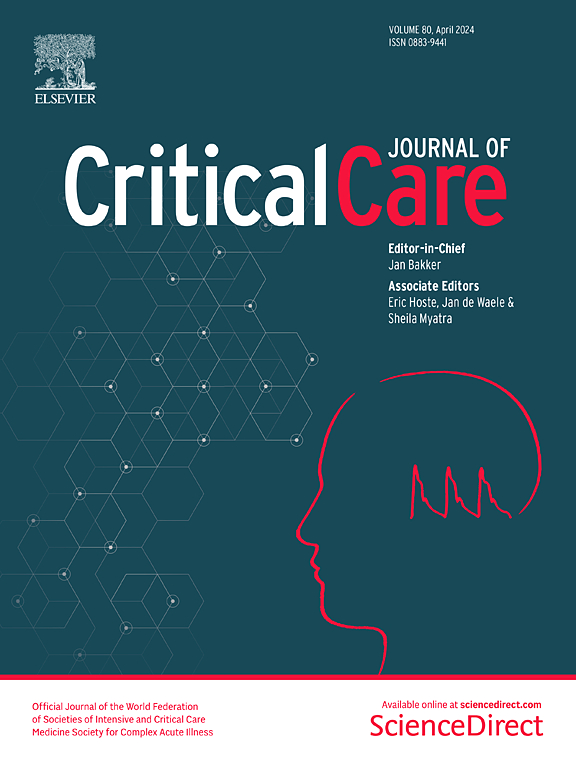Muscle weakness after critical illness: unravelling biological mechanisms and clinical hurdles
IF 8.8
1区 医学
Q1 CRITICAL CARE MEDICINE
引用次数: 0
Abstract
Survivors of intensive care unit (ICU) are increasingly numerous because of better hospital care. However, several consequences of an ICU stay, known as post-intensive care syndrome, worsen long-term prognoses. A predominant feature in survivors is reduced muscle strength, mass, and physical function. This leads to lower exercise capacity, long-lasting physical disability, higher mortality risk, and subsequent health costs. While ICU-acquired muscle weakness has been extensively studied these past decades, underlying mechanisms of post-ICU muscle weakness remain poorly understood, and there is still no evidence-based treatment for improving long-term physical outcomes. One hypothesis, among others, could be that the pathophysiology is dynamic over time, differing between the acute ICU and post-ICU recovery periods. This narrative review aims to address the clinical, physiological and biological determinants of persistent muscle dysfunction in ICU survivors, with particular attention to the molecular, cellular and systemic mechanisms involved. Specifically, pre-ICU health factors such as obesity and sarcopenia, ICU-related complications and treatments, and post-ICU management all influence recovery. Dysfunctions in the neuroendocrine, vascular, neurological, and muscle systems contribute as physiological determinants of the muscle weakness. Complex and multifaceted biological mechanisms drive the post-ICU muscle dysfunction with mitochondrial and autophagy dysfunction, epigenetic modifications, cellular senescence, muscle inflammation with altered cell–cell communication, including dysfunction of immune cells, stem cell exhaustion and extracellular matrix remodelling. The review also sheds light on new and innovative therapeutic approaches and discusses future research directions. Emphasis is placed on the potential for multi-approach treatments that integrate nutritional, physical, and biological interventions. Addressing these aspects in a holistic and dynamic manner, from ICU to post-ICU phases, may provide avenues for mitigating the long-term burden of muscle weakness and physical disability in ICU survivors.危重疾病后的肌肉无力:解开生物学机制和临床障碍
由于医院护理的改善,重症监护病房(ICU)的幸存者越来越多。然而,ICU住院的一些后果,即重症监护后综合症,会使长期预后恶化。幸存者的一个主要特征是肌肉力量、质量和身体功能下降。这导致运动能力下降,长期身体残疾,更高的死亡风险,以及随之而来的健康成本。虽然在过去的几十年里,icu获得性肌无力已经得到了广泛的研究,但icu后肌无力的潜在机制仍然知之甚少,并且仍然没有基于证据的治疗方法来改善长期的身体状况。其中一种假设是,病理生理随时间变化是动态的,不同于ICU急性期和ICU后恢复期。这篇叙述性综述旨在解决ICU幸存者持续肌肉功能障碍的临床、生理和生物学决定因素,特别关注所涉及的分子、细胞和系统机制。具体而言,icu前的健康因素,如肥胖和肌肉减少症,icu相关并发症和治疗,以及icu后的管理都影响康复。神经内分泌、血管、神经和肌肉系统的功能障碍是肌肉无力的生理决定因素。复杂和多方面的生物学机制驱动icu后肌肉功能障碍,包括线粒体和自噬功能障碍、表观遗传修饰、细胞衰老、细胞间通讯改变的肌肉炎症,包括免疫细胞功能障碍、干细胞衰竭和细胞外基质重塑。综述还揭示了新的和创新的治疗方法,并讨论了未来的研究方向。重点放在综合营养、物理和生物干预的多方法治疗的潜力上。从ICU到后ICU阶段,以整体和动态的方式解决这些问题,可能为减轻ICU幸存者肌肉无力和身体残疾的长期负担提供途径。
本文章由计算机程序翻译,如有差异,请以英文原文为准。
求助全文
约1分钟内获得全文
求助全文
来源期刊

Critical Care
医学-危重病医学
CiteScore
20.60
自引率
3.30%
发文量
348
审稿时长
1.5 months
期刊介绍:
Critical Care is an esteemed international medical journal that undergoes a rigorous peer-review process to maintain its high quality standards. Its primary objective is to enhance the healthcare services offered to critically ill patients. To achieve this, the journal focuses on gathering, exchanging, disseminating, and endorsing evidence-based information that is highly relevant to intensivists. By doing so, Critical Care seeks to provide a thorough and inclusive examination of the intensive care field.
 求助内容:
求助内容: 应助结果提醒方式:
应助结果提醒方式:


